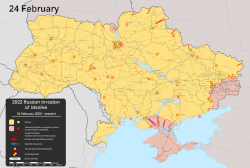Operation

The Indian government through its Embassy in Kyiv issued advisories before the conflict through its communication channels. [30] It had mixed impact. [30] Approximately 4000 Indian nationals left Ukraine before the closure of airspace over the affected areas on the morning of 24 February. [31] [32] The first Indian government advisory was issued on 15 February which was followed by stronger advisories. [33] As it was becoming increasingly difficult to provide assistance to the growing numbers the embassy, on 26 February, advised students not to go to border posts without prior coordination from the embassy. [34] On 28 February, the MEA advised all Indian citizens in Ukraine to move to and seek shelter in the towns of western Ukraine and to go to the border only after coordinating with Indian authorities. [35] The MEA set up multiple information dissemination and communication channels— a round the clock helpline, email, website, fax, other phone numbers [36] —and later on a Twitter handle. [37] The Indian Community Welfare Fund, for Indian citizens in other countries in distress, is activated. [38] [39] [40]
Between 24 February and 7 March, the Indian Prime Minister talked to Ukrainian President Volodymyr Zelenskyy and Russian President Vladimir Putin multiple times about the situation, during which Modi expressed his belief the evacuations were important and acknowledged the warring nations' assistance of them. [41] [42]
A survival advisory on 3 March, put together by Manohar Parrikar Institute for Defense Studies and Analyses, targeted those still in Ukraine and specifically Kharkiv. [24] [25] This included sharing WhatsApp geolocations, usage of a white flag and learning some Russian lines. [24] [25] By mid-6 March, the MEA control room had received over 12,400 calls and 9000 e-mails. [43] On the same day, the Embassy of Ukraine also tweeted the utilization of Google Forms to collect data of those still left in Ukraine. [44] The first flight took place on 26 February from Bucharest in Romania and reached Delhi on 27 February at 2:55 am Indian Standard Time (IST). [12] [45] By 27 February 2022 (Day 3), 469 students were evacuated. [45] By 1 March, over 2000 nationals were back. [46] The next five days saw the number climb to about 16,000. [26] Airlines assisting the evacuation included the private carriers AirAsia India, [47] Air India, IndiGo, Air India Express and SpiceJet. [3] [46] The Indian Air Force provided additional support; multiple C-17 Globemasters were utilized, [3] along with Ilyushin Il-76 aircraft on standby. [8] The evacuations were coordinated with COVID-19 pandemic protocols at airports. [33] IndiGo and Air India went on to carry out the maximum number of flights. [27] AirAsia India operated multiple flights from Budapest to Hungary and Suceava in Romania to Delhi. Additionally, the airline operated 16 domestic flights in collaboration with Governments of Odisha and Kerala to facilitate the onwards journey of over 2,500 Indians evacuated as part of Operation Ganga. [48]
Prime Minister Narendra Modi dispatched special envoys to assist coordination efforts. The special envoys were high level Union Ministers – ministers of civil aviation, transport, law, and petroleum and natural gas. [13] Jyotiraditya Scindia would assist coordination from Romania and Moldova, Kiren Rijiju from Slovakia, Hardeep Singh Puri from Hungary and General V. K. Singh from Poland. [13] By 28 February the Prime Minister had chaired at least three high level meetings related to the operation with the external affairs minister and secretary and the national security advisor. [49] [50] The PM (head of government) briefed the President of India Ram Nath Kovind (head of state) on the situation on 1 March. [51] On 2 March India, including through its National Disaster Response Force (NDRF) stocks, sent a batch of humanitarian relief in form of medical aid, tents, blankets, sleeping mats and solar lamps. [52] [53] [54]
On 10 March, the last stranded Indian Nationals of about 600 from Ukraine's Sumy were brought to Rzeszow airport in Poland via 13 buses, [55] and then were finally brought back to India on 11 March via three flights, accomplishing the operation. On the same day, India's Minister of External Affairs S. Jaishankar on Twitter hailed the operation, thanking everyone who were responsible and helped to accomplish this mission. Prime Minister Narendra Modi interacted with Indian diaspora who were at the forefront of the operation in respective neighbouring countries via video conferencing. [56]
















